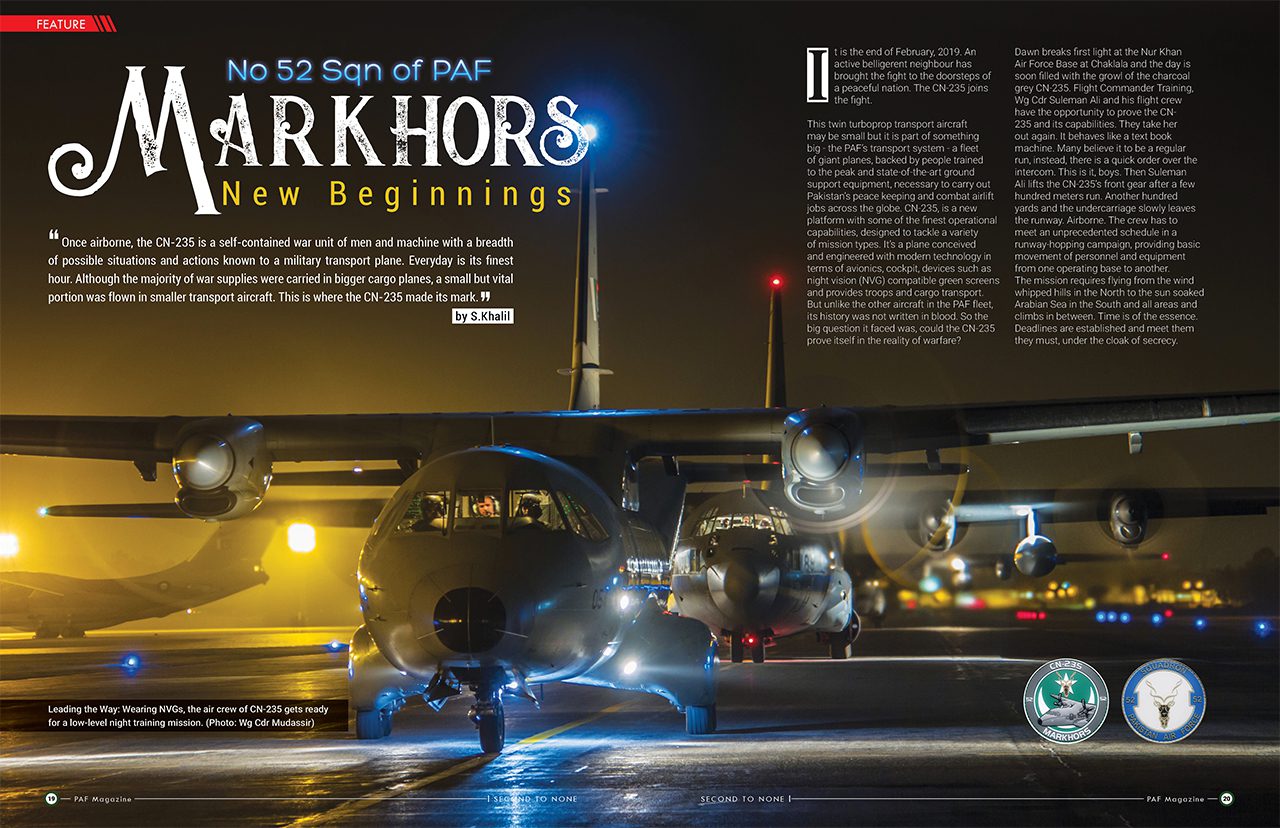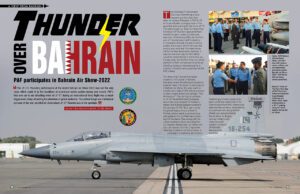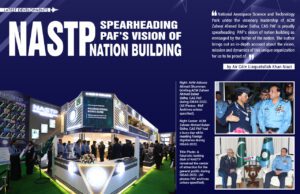Once airborne, the CN-235 is a self-contained war unit of men and machine with a breadth of possible situations and actions known to a military transport plane. Everyday is its finest hour. Although the majority of war supplies were carried in bigger cargo planes, a small but vital portion was flown in smaller transport aircraft. This is where the CN-235 made its mark.
It is the end of February, 2019. An active belligerent neighbour has brought the fight to the doorsteps of a peaceful nation. The CN-235 joins the fight.
This twin turboprop transport aircraft may be small but it is part of something big – the PAF’s transport system – a fleet of giant planes, backed by people trained to the peak and state-of-the-art ground support equipment, necessary to carry out Pakistan’s peace keeping and combat airlift jobs across the globe. CN-235, is a new platform with some of the finest operational capabilities, designed to tackle a variety of mission types. It’s a plane conceived and engineered with modern technology in terms of avionics, cockpit, devices such as night vision (NVG) compatible green screens and provides troops and cargo transport. But unlike the other aircraft in the PAF fleet, its history was not written in blood. So the big question it faced was, could the CN-235 prove itself in the reality of warfare?
Dawn breaks first light at the Nur Khan Air Force Base at Chaklala and the day is soon filled with the growl of the charcoal grey CN-235. Flight Commander Training, Wg Cdr Suleman Ali and his flight crew have the opportunity to prove the CN-235 and its capabilities. They take her out again. It behaves like a text book machine. Many believe it to be a regular run, instead, there is a quick order over the intercom. This is it, boys. Then Suleman Ali lifts the CN-235’s front gear after a few hundred meters run. Another hundred yards and the undercarriage slowly leaves the runway. Airborne. The crew has to meet an unprecedented schedule in a runway-hopping campaign, providing basic movement of personnel and equipment from one operating base to another.
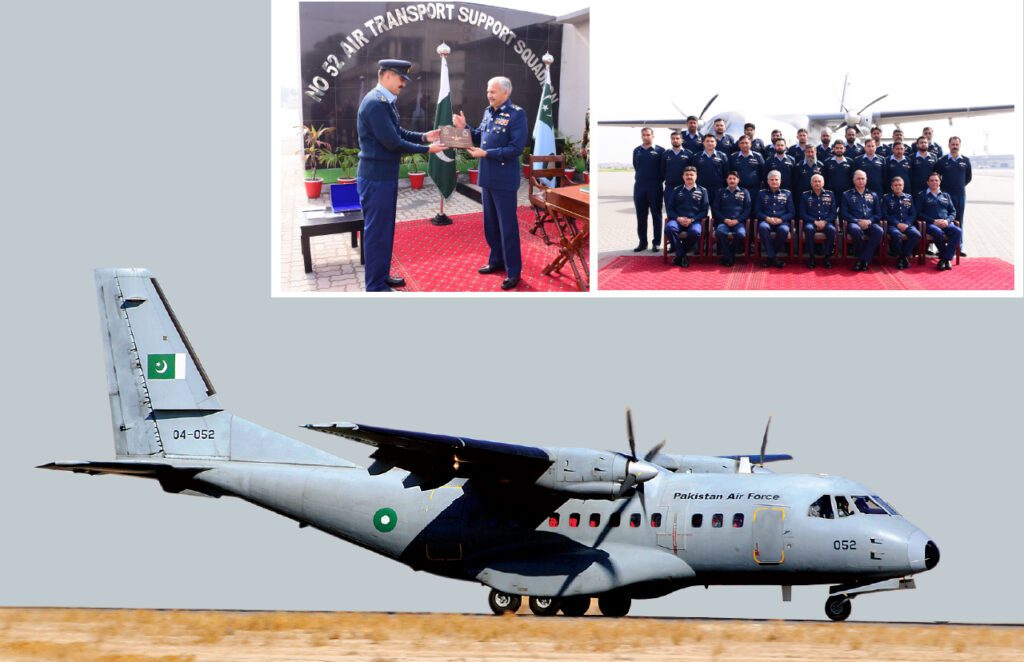
The mission requires flying from the wind whipped hills in the North to the sun soaked Arabian Sea in the South and all areas and climbs in between. Time is of the essence. Deadlines are established and meet them they must, under the cloak of secrecy.
First stop, Peshawar. The 34 paratroopers seated along the side wall disembark, and ammunition for JF17 is loaded into CN-235’s belly to be moved to Kamra. At Kamra, a team of technicians is urgently required to be deployed at PAF Base Rafiqui, home of the Mirages. Engines are running, the team comes on board. The bird is in the air again.
“CN-235 gives us the kind of flexible response that we require to meet today’s PAF policy. Every war has been influenced by logistics. Success in the battle field depends on the supply time. CN-235s were configured for transporting high priority items – and the men, perhaps the most important cargo,” Suleman Ali said. No sooner as the plane parks at the Rafiqui Air Force Base, and the technicians spill out of the ramp, Flight Commander Suleman Ali is ready for another mission. He is tasked to fly to Faisal air force base in Karachi to drop off a jet engine on an urgent basis. The Loadmaster balances the cargo properly.
In CN-235, Multan seems far, and Karachi farther. The twin engine plane is launched again on the roughly three hours journey and reaches cruise speed of 200 knots flying at 15, 000 feet. Halfway across the country, and just when the crew is beginning to enjoy the freedom in three dimensions, and experience the magical feeling of seeing the world from above, fellow aviators soar past them like an eagle in their C-130, 5,000 feet above.
“We are the slowest plane on the block and our fellow aviators love rubbing it in that we’ll miss some fun because we won’t make it the same day. Even the guys in the Hercules feel like kings of speed when they fly right past us.”
“Markhor 21, this is Hercules 30. Looks like we are going to miss you at dinner at Dolmen Mall tonight, again,” said the captain of the C-130 in a deep, calm and professional voice. Suleman Ali immediately recognized his buddy from the No 6 Sqn. “And you just know they are smiling,” he quipped.
But there have been times when, even half an hour late, CN-235 crew have managed to land first while the Hercules pilots were managing their track and descent in line with the landing sequences as demanded by the ATC. Those were also the moments when Suleman Ali would take over from the marshaller and get even by helping the C-130 pilots park at PAF Faisal. Even though the faster Hercules, with plenty of deck space to move oversized loads and able to land on unprepared grass and dirt landing strips hacked out of jungles, landed at Karachi way before, they forgot that the CN-235 has a 20 to 30 minutes turnaround time.
Exactly 25 minutes after landing the CN-235 crew are ready to take off once more for another hour long journey. Releasing brakes, Suleman Ali opens up the throttle and away she roars down the runway. Air speeds alive, gear up. They are headed to Gwadar to pick up priority cargo to be delivered to Jacobabad, home of the F-16s. The cargo is confidential, unknown even to the captain. Two hours later, at Jacobabad, Suleman Ali is ordered to maneuver to a hot bed (restricted area) to airlift munitions, to be transported two hours away to fighter town Sargodha, another hub of the F-16s. Engines run to full military power and the breaks are released. CN-235 begins to roll and the nose is lifted to take off altitude. Skies are clear, the air is mild and there is a slight breeze from the south, and CN-235 casts shadow on earth.
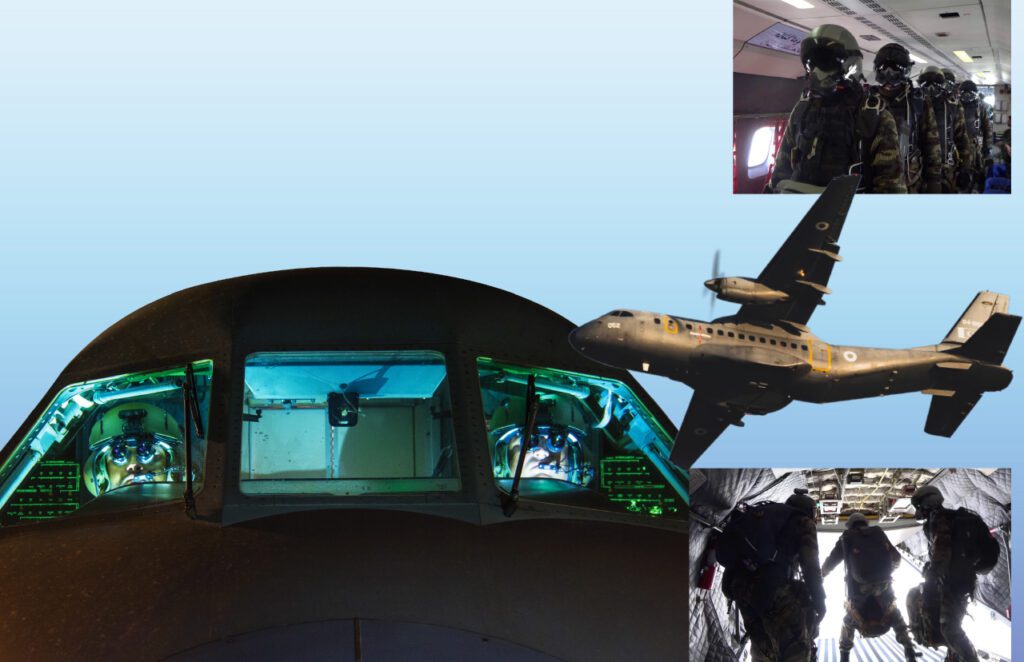
It has been a long day for the pilots. It is tough, non-stop flying for the crew. They return to Chaklala in the gathering dusk from their last mission. Despite the hardship of continuous flying, CN-235 is ready for combat. It can get troops where they need to go and it can do it in the toughest environments. PAF celebrates another proud day of operations.
Daily life at Nur Khan (Chaklala) is no day at the beach. But the No 52 Sqn has its moments – a day to remember with brothers and in a career over a cup of tea and sandwiches. Soon they got their report card from their ultimate authority in person, the Chief of Air Staff, Pakistan Air Force, Air Chief Marshal Mujahid Anwar Khan. In January, 2020, a new unit was dedicated to the CN-235 under the No 35 Flying Wing, the largest flying wing of PAF. He came to see the operations of the No 52 Sqn first hand. The Air Chief liked what he saw, that the No 52 Sqn is making history, that the introduction of the aircraft into the battle field has been incremental. When war came, the CN-235 proved a stalwart defender. The Markhor insignia is an appropriate symbol for the men of the No 52 Sqn.
Out of the four brand new CN-235 that entered service in 2004, one is dedicated for VIP movements including the Air Chief. Few planes can match the knockout punch of the CN-235. Its engines can sustain battle damage. It is also endowed with the Radar Warning Receiver (RWR), which issues an alert when it detects a radar signal from an enemy jet. This timely alert helps CN-235 pilots avoid detection. Operated by a crew of four, pilot, co-pilot, flight engineer and load master, all of which are necessary for tactical missions. Among its best features is its lower operating costs. The CN-235 can reach Karachi in 2, 500 lbs of fuel. Compared with other heavy transport planes in the PAF inventory such as the IL-78 air-to-air refueler that guzzles 22, 000 lbs fuel every hour and the C-130, which burns 5, 000 lbs per hour, the CN-235 consumes only 700 to 800 lbs gasoline every 60 minutes. Like a first class race car the CN-235’s horsepower is awesome. However, its greatest strength is its slow-speed maneuverability.
First Officer Commanding of the new No 52 Sqn Wg Cdr Arif Ali Khan’s affection for the CN-235 surfaces in a variety of ways. “It is an aeroplane for all intents and purposes when it goes sour on us. The air force needed the ability to respond all out. In some ways we were short of military readiness for small and scattered actions anywhere. The PAF began asking the right questions such as what must we haul, how far, how fast, and at what cost, covering significant battle space. This called for a plane that would deliver men and their equipment into the combat area ready to fight and for effective steps ahead in the PAF’s transport planning,” Wg Cdr Arif Ali Khan said. Moreover, back in early 2000s when the plan to induct a new cargo aircraft was deliberated upon, there was something else also in the minds of PAF planners. They had realised that the C-130 fleet had taken lot of beating over decades. Sometimes, the fleet was used for short hops and legs contrary to its basic role of moving heavy loads on long hauls. That’s why, they decided to conserve this strategic asset as the war time reserve and use it more judiciously. This thought led to the induction of CN-235 into PAF fleet. Wg Cdr Arif Ali believes that reliability is a very good friend to have. “We have to admit that this plane fills an important gap. Its missions are testimony to the unforgettable role CN-235 has played in the past,” he said.
Besides its effective role in combat, the CN-235 has brought food to the hungry, relief to the victims of natural disaster and hope to almost inaccessible corners of the country. In 2005, when a devastating earthquake shattered thousands of lives, the angel-of-mercy CN-235 embraced a new mission and it set the bar still higher. The transport plane flew 100 plus low altitude sorties through narrow gusty valleys, where the faster, heavier Hercules found it difficult to get into. “We flew from sunrise to sunset air dropping medicines, tents, and rations for the displaced families. CN-235 has played an integral role in strategic airlift and significant delivery of humanitarian aid. In 2005, it became the primary airlifter for relief operations across Balakot, Batagram and Neelum Valley to mention some difficult terrain,” said Gp Capt Asim Hafeez (Retd), one of the pioneering CN-235 pilot.
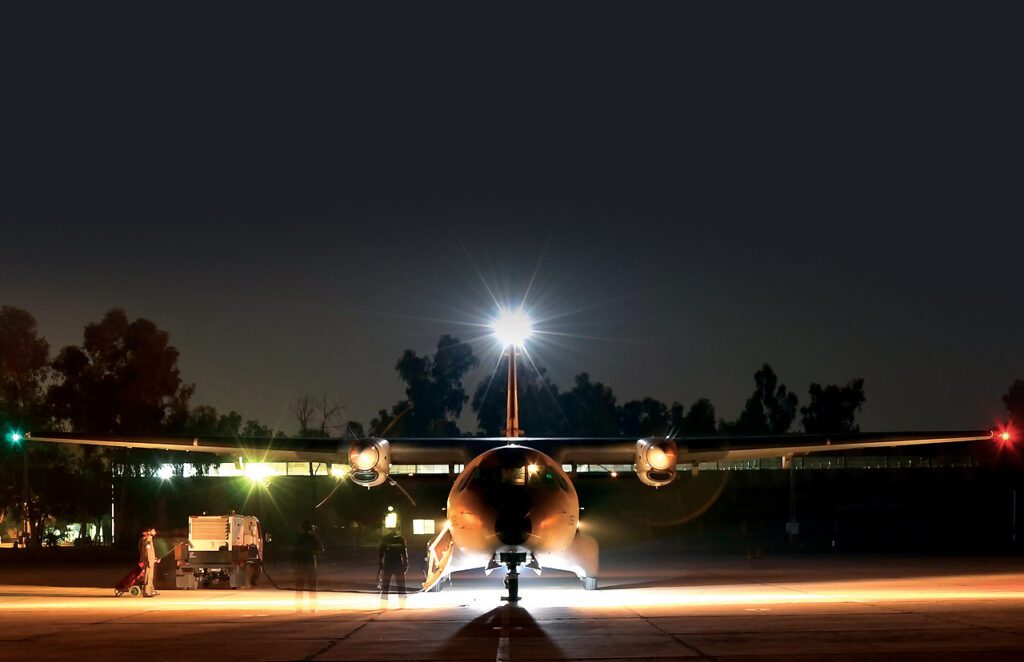
“Given the urgency of the relief missions, in this jack of all trades plane, we could turn off the propellers without switching off engines for the safety of ground crew while loading cargo. This capability reduced the turnaround time and enabled us to fly five to six sorties a day to reach maximum victims of the catastrophe,” said Asim Hafeez.
Back in early 2000s, the ferry flights of brand new CN-235 from Indonesia were also very eventful. “I was tasked to ferry the last CN-235 aircraft to PAF, the VIP version, in 2006. After carrying out number of test flights at IAE (Indonesian Aerospace) facility, the next task was to ferry this brand new bird to Pakistan. Owing to its slow speed, it took us three days to reach Pakistan, making night stops at Male (Maldieves) and Colombo (Srilanka). The complete itinerary of our route was Bandung (Indonesia) –Banda ache (Indonesia)-Male (Maldives)-Colombo (Sri Lanka)-PAF Faisal (Karachi)”. Memories of avoiding dangerous weather while flying over beautiful beaches and landscapes are still fresh in our minds”, reminisces Asim Hafeez.
CN-235 engineers and technicians wanted to be the tip of the spear, and the No 52 Sqn was the right place to be. They have proved vital all along. Its a treat to see how naturally they go about their routine jobs, jobs without which no combat mission can leave the ground. These young men are adepts at highly technical jobs. Every time one of these birds flies, it runs on their blood, sweat and tears. Sticking with CN-235 engineer, Sqn Ldr Abdul Samad, showed how it’s really done. For the technical staff, the planes under their care are breathing, living things. They have to be in sync with the mechanical heartbeat of these giant birds. CN-235 has been built with state-of-the-art aviation technology. However, this does not mean that it does not require constant scrutiny and inspection from the technical staff. Fortunately, PAF’s men of technical prowess more than rise to the occasion. It was no easy task, though. “The aircraft is young, just 16 years strong. We don’t have a technical information database to consult when tackling problems with the aircraft. However, its young age and competent build also ensures that it has relatively less problems to begin with.” Illuminates CN-235 engineer, Sqn Ldr Abdul Samad.
Sometimes, the aircraft gives us technical problems that needs detailed scrutiny and takes lots of time to pin point the root cause. Nonetheless, this is more than just a good machine with a pretty good tour of service. It represents a distinct way of life,” he said. In the practiced hands of the No 52 Sqn, the CN-235 now stands poised for duty.
“Owing to the tonnages we have to move and resupply, our operations are large. We have to move them to different places, get them there rapidly. When the CN-235 arrived in the inventory, it permitted the PAF to do its job far more efficiently and effectively, expanding operational range,” said OC No 52 Sqn Wg Cdr Arif Khan, who described CN-235 as one of the most versatile and sophisticated military transport planes in its category. And although the air battle on Feb 27, 2019, was won by jets, ultimate victory hung in the balance of all Pakistan Air Force operations. Many pilots owed their success to this versatile aircraft. Its crew knew who to thank – the reliable CN- 235. This is where the No 52 Sqn earned their keep.
